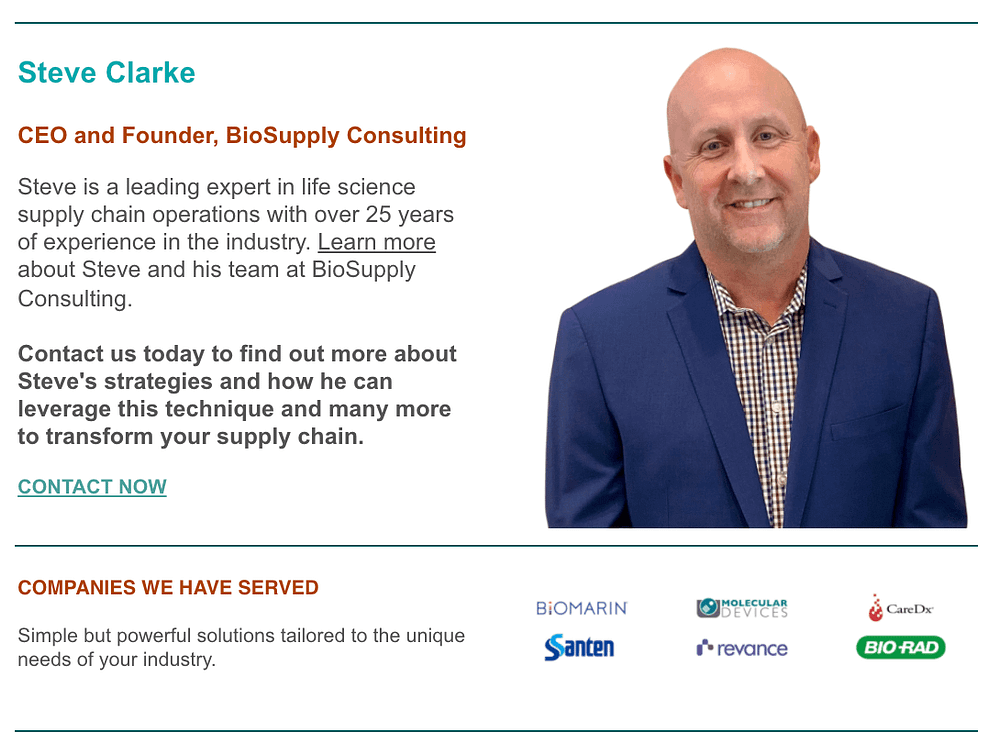LIFE SCIENCE SUPPLY CHAIN SOLUTIONS BY STEVE CLARKE
In this week’s newsletter, I will start to share excerpts from my upcoming book, which has been written with the life science supply chain leader in mind. In the book, I present a framework for rapidly and sustainably transforming your supply chain performance and capability. This framework can be applied to any industry, but I deliberately selected many anecdotes and stories from my own experiences. In addition, there were several life science supply chain leaders who generously volunteered their time and contributed to the book. This excerpt speaks to how to align your supply chain metrics with your strategic objectives. For example, let’s say that your organization has set a goal of improving customer satisfaction with your supply chain performance. You would need to select metrics that measure your progress to this objective.
Excerpt:
“…. A simple way to align supply chain metrics is for each company in a supply chain to ask its customers, “How do you measure the performance of your suppliers?” When the suppliers have that information, they can adopt those metrics as their own. When you and your suppliers look at the same metrics, it becomes much easier to collaborate on improvements that will benefit all of you. Start with the overall desired outcome of a particular supply chain (for example, on-time delivery needs to be 99.2%), and then make the most of the detailed functional metrics in relation to each other to arrive at that desired outcome. Otherwise, if you set a target for each functional metric independently of other metrics, you will have no idea even if you meet the target set for every metric, will it be enough to satisfy the customer….” In other words, what are the key drivers that impact on-time delivery? In the book, I describe how to utilize transactional data and root cause analysis to identify these key drivers and related metrics. Finally, I explain how set targets for the Level 2 metrics that will help achieve the Level 1 metric, in this case on-time delivery of 99.2%. For example, say your current on-time delivery is 89.2%, so you know that you need to improve by 10 points to achieve 99.2%. When you perform a deep dive on recent customer orders that were delivered late, you find that 80% of these late orders could be explained by late supplier deliveries (50%) and forecast error (30%). So now you have found the metrics to focus on: on-time supplier delivery and forecast accuracy. In other words, if you were to wave a magic wand and now all supplier deliveries were on-time, and forecasts were completely accurate, you could instantly improve on time delivery by 8 points to 97.2% (89.2 + 10). In the real world, however, we know that we can’t rely upon perfection in these areas, so we perform the same analysis for late supplier deliveries and forecast errors, to find out what are the critical causes, and how much control do we have over them. Now this may sound like too much analysis and effort but believe me it is not. I recently performed this analysis with a life science client. Within a 90-minute workshop, I had all the data I needed, and within a couple of days, we had performed the analysis. Keep in mind, that on-time delivery had been an issue at this company for several years and had never been fixed. By the following week, we had developed solutions and were well on the way to meet their customer service objective.
Testimonial
“Re-built the supply chain processes which improved efficiency and reduced the operational churn”.
~(Cliff Wylie, Senior Director, Supply Chain Planning)



